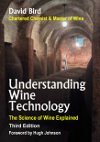David Bird
Audits
Contact
Photos
The book
Introduction
Foreword
Contents
Chapter 9
Buy it

Front cover
Table of Contents
Chapter 1: THE GIFT OF NATURE
-
The origins of wine
The natural cycle
Enzymes in nature
Wine and health
-
Alcohol
Flavonoids
Resveratrol
Potassium
Histamine
Chapter 2: IN THE VINEYARD
-
The vine
Phylloxera & grafting
Climate
Training & pruning
Soil & water
Irrigation
Green harvest
Terroir
Vineyard systems
-
Viticulture Raisonée (La Lutte Raisonée)
Organic viticulture
Biodynamic viticulture
Chapter 3: INSIDE THE GRAPE
-
Sugars
Acids
Mineral salts
Phenolic compounds
-
Tannins
Anthocyanins
Proteins & colloids
Véraison & maturity
Chapter 4: THE ROLE OF OXYGEN
-
Old-style winemaking
Anaerobic winemaking
Antioxidants
Inert gases
-
Carbon dioxide
Nitrogen
Argon
Sparging
The positive role of oxygen
Chapter 5: PRODUCING THE MUST
-
Harvesting the grapes
-
Picking by hand
Machine harvesting
Sorting
De-stemming
Crushing the grapes
Draining the juice
Pressing the berries
-
The basket press
Horizontal screw press
Pneumatic press
Tank press
Continuous screw press
Chapter 6: ADJUSTING THE MUST
-
Sulphur dioxide
Clarification (white and pink wines)
-
Settling
Centrifuging
Flotation
Acidification
Deacidification
-
Acidex
Must concentration
-
Vacuum distillation
Cryo-extraction (cryo-concentration)
Reverse osmosis
Other treatments
-
Bentonite
Activated charcoal
Tannin
Chapter 7: FERMENTATIONS
-
Yeasts
The action of yeasts
Natural fermentation
Cultured yeasts
Control of temperature
Monitoring the fermentation
Stopping the fermentation
A 'stuck' fermentation
Naturally sweet wines
The malo-lactic fermentation
Chapter 8: RED & PINK WINE PRODUCTION
-
Fermentation vessels
Maceration
Traditional process
Submerged cap process
Pumping-over systems
Délestage (Rack and return)
Autovinifier
Rotary fermenters
Thermo-vinification
Flash détente
Carbonic maceration (macération carbonique)
Variants on carbonic maceration
-
Whole bunch fermentation
Whole berry fermentation
-
Short maceration
Saignée
Vin d'une nuit
Double pasta
Chapter 9: WHITE WINE PRODUCTION
-
Cool fermentation
Skin contact (macération pelliculaire)
Tank vs. barrel
Sur lie
Bátonnage
Prevention of oxidation
Sweet wines
Carafe wines
German wines
Sauternes
Tokaji Aszú
Chapter 10: SPARKLING & FORTIFIED PROCESSES
-
Sparkling wines
-
Traditional method
Transfer method
Tank method (cuve close or Charmat)
Carbonation ('Pompe bicyclette')
The Asti method
-
Vins doux naturelles (VDN)
Port
Port styles
Sherry
Madeira
Marsala
Chapter 11: WOOD & MATURATION
-
Type of wood
Oak
Size of vessel
Seasoning and toasting
Fermentation in barrel
Maturation in wood
Putting the wood in the wine
Micro-oxygenation
Chapter 12: PRINCIPAL COMPONENTS OF WINE
-
Alcohols
Acids
Esters
Residual sugars
Glycerol
Aldehydes and ketones
Chapter 13: CLARIFICATION & FINING
-
Is treatment necessary?
Racking
Protection from oxidation
Blending
Fining
Fining agents
-
Ox blood
Egg white
Albumin
Gelatine
Isinglass (ichthyocol or col de poisson)
Casein
Tannin
Bentonite
Silica sol (Kieselsol)
Polyvinylpolypyrrolidone (PVPP)
Activated charcoal
Allergens
Calcium phytate
PVI/PVP copolymers
Chitin-glucan complex and chitosan
Chapter 14: TARTRATE STABILISATION
-
Natural and harmless?
Cold stabilisation
Contact process
Ion exchange
Electrodialysis
Metatartaric acid
Carboxymethylcellulose (cellulose gums)
Mannoproteins
Minimum intervention
Chapter 15: ADDITIVES
-
Sulphur dioxide
-
Free and total sulphur dioxide
Molecular sulphur dioxide
Sorbic acid
Metatartaric acid
Citric acid
Copper sulphate or silver chloride
Acacia (Gum arabic)
Enzymes
-
Pectinolytic enzymes
Betaglucanase
Lysozyme
Laccase
Tyrosinase
Chapter 16: FILTRATION
-
Principles of filtration
Depth filters
-
Kieselguhr filtration (earth filtration)
Sheet filtration (plate & frame or pad filtration)
-
Membrane filtration (cartridge filtration)
Cross-flow filtration (tangential filtration)
Chapter 17: PACKAGING MATERIALS
-
Containers
-
Glass bottles
Measuring container bottles (MCBs)
Plastic bottles
Aluminium cans
Bag-in-box (BIB)
Cardboard 'bricks'
-
Natural cork
Technical corks
Synthetic closures
Aluminium screwcaps
Glass stoppers
Other closures
-
Lead foil
Pure tin
Tin-lead
Aluminium
PVA
Polylaminated
Chapter 18: STORAGE & BOTTLING
-
Storage without change
The final sweetening
Shipping in bulk
Bottling processes
Traditional bottling
'Sterile' bottling
Principles of modern bottling
Dimethyldicarbonate (DMDC)
Modern bottling techniques
-
Bottle rinsing
Thermotic, or hot bottling
Tunnel pasteurisation
Flash pasteurisation
Cold sterile filtration
Chapter 19: QUALITY CONTROL & ANALYSIS
-
Quality plan
Records and traceability
Laboratory analyses
-
Density
Alcoholic strength
Total dry extract (TDE)
Total acidity
pH
Volatile acidity
Residual sugars
Tartrate stability tests
Protein stability tests
-
Sulphur dioxide
Other additives
-
Dissolved oxygen
Iron and copper
Sodium
Microbiological analysis
Chapter 20: WINE FAULTS
-
Oxidation
Reductive taint
Beyond shelf-life
Tartrate crystals
Foreign bodies
Musty taint
Volatile acidity
Second fermentation
Iron casse
Copper casse
Mousiness
Brett
Geranium taint
Chapter 21: THE TASTE TEST
-
Preparations for tasting
-
Temperature
Decanting
Styles of tasting
-
Tasting in front of the label
Comparative tasting
Blind tasting
Tasting the wine
-
Appearance
Nose
Palate
Conclusion
Chapter 22: QUALITY ASSURANCE
-
Hazard analysis and critical control points(HACCP)
-
Principles of the HACCP system
The process
The application to a winery
Interpretation
ISO 14000:2004
ISO 22000:2005
Supplier audits
The BRC Global Food Standard
Business Excellence Model
Chapter 23: LEGISLATION & REGULATIONS
-
Regulation 479/2008: Common Organisation of the Market in Wine
Regulation 606/2009: Detailed rules
Regulation 607/2009: More detailed rules
Regulation 1991/2004: Declaration of allergens
Directive 1989/396: Lot marking
Regulation 178/2002: Traceability
Directive 2000/13: Labelling, presentation & advertising
Weights & Measures (Packaged Goods) Regulations 2006
Weights & Measures (Specified Quantities) Regulations 2009
Food Safety Act 1990
Food Safety (General Food Hygiene) Regulations 1995
Glossary